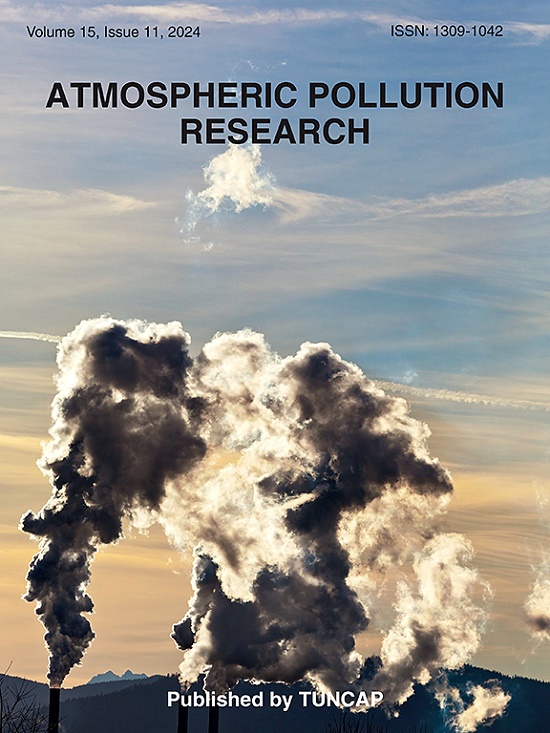Investigating the role of meteorological parameters in the transport of air pollutants from LPG tank trailer explosion in Jaipur, India
IF 3.5
3区 环境科学与生态学
Q2 ENVIRONMENTAL SCIENCES
引用次数: 0
Abstract
Air pollution is a growing concern, especially during episodic events that significantly impact air quality and public health. This study examined the impact of air pollutants from an Liquefied Petroleum Gas (LPG) tank trailer explosion in Jaipur, focusing on pollutant transport and the role of meteorology in air quality changes in Jodhpur. The air quality across three phases Pre-Event, During-Event, and Post-Event was assessed by examining variations in pollutant (i.e., PM2.5, PM10, CO, NH3) concentrations and their relationships with meteorological parameters. During the Pre-Event, PM2.5 was low, while PM10 were moderate. During the Event period, PM2.5 and PM10 concentrations surged severely to 380 μg/m3 and 430 μg/m3, respectively. CO peaking at 18.3 mg/m3, and NH3 at 17.2 μg/m3, reflecting severe air quality deterioration. The Air Quality Index (AQI) level was 372 in the Pre-Event and reached 435 during the Event. Air Pollutant concentrations and AQI improved post-event due to wind and atmospheric mixing. Meteorological factors, including humidity, boundary layer height, and wind speed, played a critical role in the transport and dispersion of pollutants, with their combined effect contributing significantly to pollutant behavior and air quality fluctuations. This study supports Sustainable Development Goals (SDG) 3 by addressing air pollution health risks, SDG 11 by emphasizing sustainable urban air quality management, and SDG 13 by examining meteorological impacts on pollution dispersion.
Overall, the study underscores the importance of meteorological conditions in shaping pollutant dispersion and highlights the need for targeted air quality management strategies to mitigate health risks from episodic pollution events.
调查气象参数在印度斋浦尔液化石油气储罐拖车爆炸产生的空气污染物运输中的作用
空气污染是一个日益令人关切的问题,特别是在严重影响空气质量和公众健康的偶发事件期间。本研究考察了斋浦尔液化石油气(LPG)储罐拖车爆炸产生的空气污染物的影响,重点关注污染物的运输和气象学在焦特布尔空气质量变化中的作用。通过检查污染物(即PM2.5、PM10、CO、NH3)浓度的变化及其与气象参数的关系,评估了事件前、事件中和事件后三个阶段的空气质量。在活动前,PM2.5较低,PM10中等。在“事件”期间,PM2.5和PM10浓度分别急剧上升至380 μg/m3和430 μg/m3。CO峰值为18.3 mg/m3, NH3峰值为17.2 μg/m3,空气质量恶化严重。空气质素指数(AQI)在事件发生前为372,而在事件发生后则达到435。由于风和大气的混合,空气污染物浓度和AQI在事件发生后有所改善。湿度、边界层高度和风速等气象因子对污染物的运移和扩散起着至关重要的作用,它们的综合作用对污染物行为和空气质量波动有重要影响。本研究通过解决空气污染健康风险来支持可持续发展目标3,通过强调可持续城市空气质量管理来支持可持续发展目标11,通过研究气象对污染扩散的影响来支持可持续发展目标13。总体而言,该研究强调了气象条件在形成污染物扩散方面的重要性,并强调需要制定有针对性的空气质量管理战略,以减轻偶发性污染事件带来的健康风险。
本文章由计算机程序翻译,如有差异,请以英文原文为准。
求助全文
约1分钟内获得全文
求助全文
来源期刊

Atmospheric Pollution Research
ENVIRONMENTAL SCIENCES-
CiteScore
8.30
自引率
6.70%
发文量
256
审稿时长
36 days
期刊介绍:
Atmospheric Pollution Research (APR) is an international journal designed for the publication of articles on air pollution. Papers should present novel experimental results, theory and modeling of air pollution on local, regional, or global scales. Areas covered are research on inorganic, organic, and persistent organic air pollutants, air quality monitoring, air quality management, atmospheric dispersion and transport, air-surface (soil, water, and vegetation) exchange of pollutants, dry and wet deposition, indoor air quality, exposure assessment, health effects, satellite measurements, natural emissions, atmospheric chemistry, greenhouse gases, and effects on climate change.
 求助内容:
求助内容: 应助结果提醒方式:
应助结果提醒方式:


